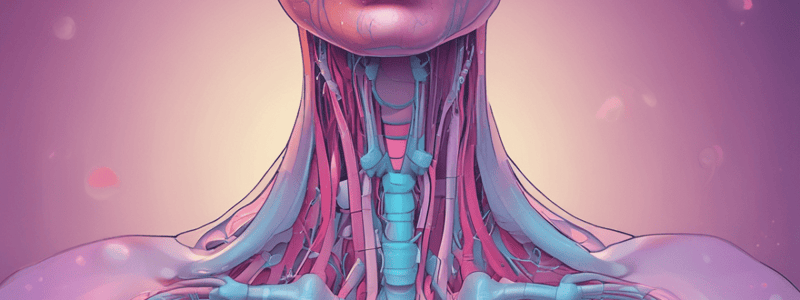Podcast
Questions and Answers
What percentage of thyroid nodules are palpable?
What percentage of thyroid nodules are palpable?
- 30-40%
- 20-30%
- 5-10% (correct)
- 10-20%
What is the primary reason for further evaluation of a thyroid nodule?
What is the primary reason for further evaluation of a thyroid nodule?
- It is benign
- It is solid or semi-solid (correct)
- It is palpable
- It is liquid
What does a low TSH level indicate?
What does a low TSH level indicate?
- Thyroid cancer
- Thyroid nodule
- Hypothyroidism (correct)
- Hyperthyroidism
What is the purpose of biopsy in thyroid nodule diagnosis?
What is the purpose of biopsy in thyroid nodule diagnosis?
What is the most common type of thyroid cancer?
What is the most common type of thyroid cancer?
What is the typical treatment for well-differentiated thyroid cancers?
What is the typical treatment for well-differentiated thyroid cancers?
¿Cuál es la característica principal de la Clase II de Angle, División 2?
¿Cuál es la característica principal de la Clase II de Angle, División 2?
¿Cuál es la característica principal de la Clase III de Angle?
¿Cuál es la característica principal de la Clase III de Angle?
¿Cuál es la característica principal de la Clase II de la clasificación canina?
¿Cuál es la característica principal de la Clase II de la clasificación canina?
¿Cuál es el nombre del plano facial que pasa a través de la sutura coronal?
¿Cuál es el nombre del plano facial que pasa a través de la sutura coronal?
¿Cuál es la característica principal de la Clase I de la clasificación ósea?
¿Cuál es la característica principal de la Clase I de la clasificación ósea?
¿Cuál es el propósito de la clasificación de Angle?
¿Cuál es el propósito de la clasificación de Angle?
¿Cuál es la relación transversal anormal entre las piezas dentales mandibulares y maxilares?
¿Cuál es la relación transversal anormal entre las piezas dentales mandibulares y maxilares?
¿Cuál es la característica del crossbite anterior?
¿Cuál es la característica del crossbite anterior?
¿Cuál es la orientación de la cara de la pieza dental hacia la lengua?
¿Cuál es la orientación de la cara de la pieza dental hacia la lengua?
¿Cuál es la clasificación de Angle que se basa en la relación del primer molar maxilar y mandibular?
¿Cuál es la clasificación de Angle que se basa en la relación del primer molar maxilar y mandibular?
¿Cuál es la característica de la Clase II de Angle?
¿Cuál es la característica de la Clase II de Angle?
¿Qué se llama a la inclinación vestibular de la pieza dental?
¿Qué se llama a la inclinación vestibular de la pieza dental?
¿Cuál es la superficie masticatoria de los premolares y molares?
¿Cuál es la superficie masticatoria de los premolares y molares?
¿Cuál es la característica de la Clase II División 1 de Angle?
¿Cuál es la característica de la Clase II División 1 de Angle?
¿Qué se llama a la rotación alrededor de su eje principal de una pieza dental?
¿Qué se llama a la rotación alrededor de su eje principal de una pieza dental?
¿Cuál es la relación de la cúspide mesiovestibular del primer molar maxilar en la Clase I de Angle?
¿Cuál es la relación de la cúspide mesiovestibular del primer molar maxilar en la Clase I de Angle?
¿Cuál es la cara de la pieza dental que se aleja de la línea media?
¿Cuál es la cara de la pieza dental que se aleja de la línea media?
¿Qué se llama a la no unión de la pieza dental con la pieza dental antagonista?
¿Qué se llama a la no unión de la pieza dental con la pieza dental antagonista?
¿Cuál es el porcentaje de riesgo de cáncer para la categoría de diagnóstico Bethesda III?
¿Cuál es el porcentaje de riesgo de cáncer para la categoría de diagnóstico Bethesda III?
¿Cuál es el tipo de cáncer tiroideo más frecuente en la edad avanzada?
¿Cuál es el tipo de cáncer tiroideo más frecuente en la edad avanzada?
¿Cuál es el marcador tumororal asociado con el carcinoma folicular?
¿Cuál es el marcador tumororal asociado con el carcinoma folicular?
¿Cuál es el pronóstico del carcinoma anaplásico?
¿Cuál es el pronóstico del carcinoma anaplásico?
¿Cuál es la característica del carcinoma papilar?
¿Cuál es la característica del carcinoma papilar?
¿Cuál es el riesgo de cáncer para la categoría de diagnóstico Bethesda VI?
¿Cuál es el riesgo de cáncer para la categoría de diagnóstico Bethesda VI?
¿Cuál es el porcentaje de riesgo de cáncer para la categoría de diagnóstico Bethesda III?
¿Cuál es el porcentaje de riesgo de cáncer para la categoría de diagnóstico Bethesda III?
¿Cuál es el tipo de cáncer tiroideo más frecuente en la edad avanzada?
¿Cuál es el tipo de cáncer tiroideo más frecuente en la edad avanzada?
¿Cuál es el marcador tumororal asociado con el carcinoma folicular?
¿Cuál es el marcador tumororal asociado con el carcinoma folicular?
¿Cuál es la característica del carcinoma papilar?
¿Cuál es la característica del carcinoma papilar?
¿Cuál es el pronóstico del carcinoma anaplásico?
¿Cuál es el pronóstico del carcinoma anaplásico?
¿Cuál es la categoría de diagnóstico Bethesda con un riesgo de cáncer del 97 a 99%?
¿Cuál es la categoría de diagnóstico Bethesda con un riesgo de cáncer del 97 a 99%?
Flashcards are hidden until you start studying
Study Notes
Thyroid Cancer Screening
- Screening is crucial in thyroid cancer diagnosis
- More than 50% of the population over 40 years old have thyroid nodules, but only 5-10% are palpable
- 95% of thyroid nodules are benign
- Thyroid cancer is more common in women than men, at a ratio of 4:1
Thyroid Nodule Diagnosis
- Thyroid nodules can be incidental findings on imaging studies
- A thyroid nodule can be solid, semi-solid, or liquid
- If a nodule is solid or semi-solid, it requires further study
- TSH (thyroid-stimulating hormone) and ultrasound are used to evaluate thyroid nodules
TSH Interpretation
- Low TSH (<0.5) suggests a high probability of thyroid cancer
- Normal TSH (0.5-5) indicates a lower probability of thyroid cancer
- High TSH (>5) may indicate hypothyroidism
Ultrasound Features
- Marginal irregularities, microcalcifications, and extrathyroidal extension are characteristics of high-risk thyroid nodules
- These features increase the likelihood of thyroid cancer
Biopsy and Cytology
- Biopsy is necessary for thyroid nodules with high-risk ultrasound features
- Cytology categorizes thyroid nodules into six categories:
- Insufficient (1)
- Benign (2)
- Indeterminate (3)
- Follicular neoplasm (4)
- Suspicious for malignancy (5)
- Malignant (6)
Thyroid Cancer Classification
- Thyroid cancer can be classified into four main types:
- Papillary carcinoma (85% of all thyroid cancers)
- Follicular carcinoma (12% of all thyroid cancers)
- Anaplastic carcinoma (3% of all thyroid cancers)
- Medullary carcinoma (rare, associated with multiple endocrine neoplasia)
Treatment
- Well-differentiated thyroid cancers (papillary and follicular) are typically treated with surgery and radioactive iodine ablation
- Poorly differentiated thyroid cancers (anaplastic and medullary) are treated with surgery, radiation therapy, and chemotherapy
- Suppressive thyroid hormone treatment is also used in some cases
Thyroid Cancer Screening
- More than 50% of the population over 40 years old have thyroid nodules, but only 5-10% are palpable
- 95% of thyroid nodules are benign
- Thyroid cancer is more common in women than men, at a ratio of 4:1
Thyroid Nodule Diagnosis
- Thyroid nodules can be incidental findings on imaging studies
- A thyroid nodule can be solid, semi-solid, or liquid
- Solid or semi-solid nodules require further study
- TSH and ultrasound are used to evaluate thyroid nodules
TSH Interpretation
- Low TSH may indicate hypothyroidism
Ultrasound Features
- Marginal irregularities, microcalcifications, and extrathyroidal extension are characteristics of high-risk thyroid nodules
- These features increase the likelihood of thyroid cancer
Biopsy and Cytology
- Biopsy is necessary for thyroid nodules with high-risk ultrasound features
- Cytology categorizes thyroid nodules into six categories:
- Insufficient
- Benign
- Indeterminate
- Follicular neoplasm
- Suspicious for malignancy
- Malignant
Thyroid Cancer Classification
- Thyroid cancer can be classified into four main types:
- Papillary carcinoma (85% of all thyroid cancers)
- Follicular carcinoma (12% of all thyroid cancers)
- Anaplastic carcinoma (3% of all thyroid cancers)
- Medullary carcinoma (rare, associated with multiple endocrine neoplasia)
Treatment
- Well-differentiated thyroid cancers (papillary and follicular) are typically treated with surgery and radioactive iodine ablation
- Poorly differentiated thyroid cancers (anaplastic and medullary) are treated with surgery, radiation therapy, and chemotherapy
- Suppressive thyroid hormone treatment is also used in some cases
Studying That Suits You
Use AI to generate personalized quizzes and flashcards to suit your learning preferences.




